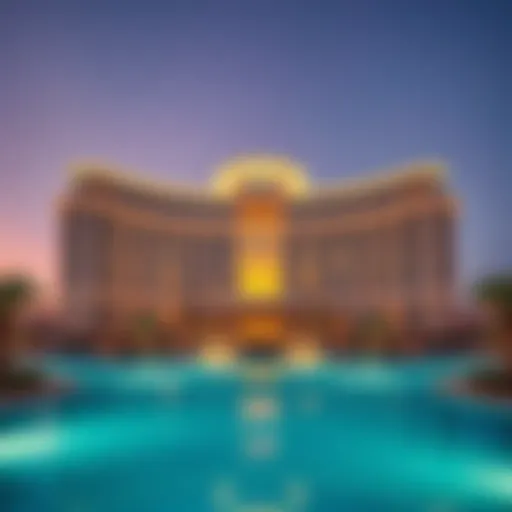Scenic Wonders of Dubai: A Journey Through Urban and Natural Landscapes
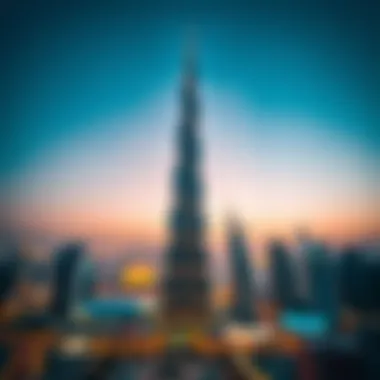
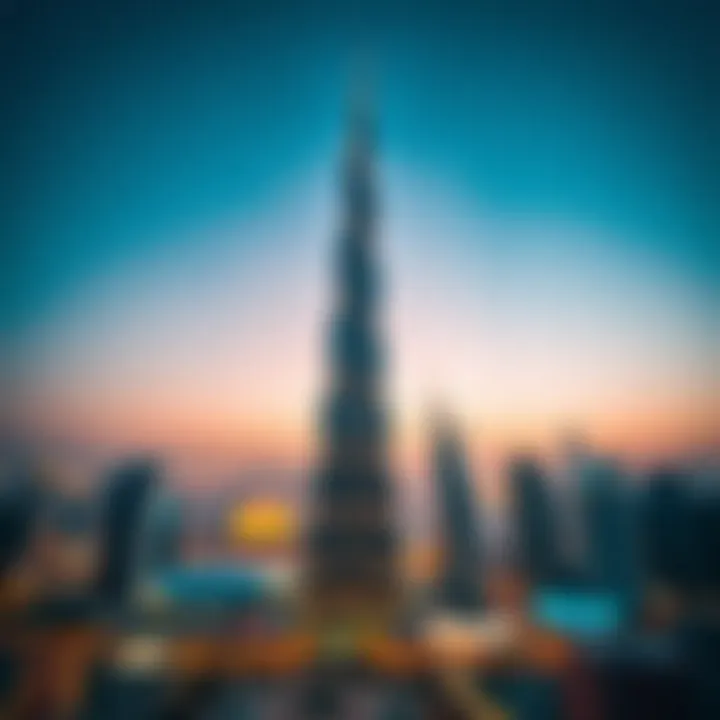
Market Trends and Insights
When it comes to the bustling real estate market in Dubai, trends shift faster than the sands in the desert. Navigating this complex landscape requires a keen insight into both current developments and future possibilities.
Current Market Analysis
Dubai's real estate sector has shown resilience and adaptability in recent years. Investors are more willing than ever to explore opportunities in districts that feature stunning scenic landscapes. The appeal isn’t solely in the property values; it’s also about the lifestyle these places promise. Projects like The Palm Jumeirah and Dubai Marina not only showcase architectural splendor but also offer picturesque views that enhance the living experience.
Several recent reports point to a steady increase in demand for both rental and owned properties amidst a backdrop of increasing urban sophistication. The increasing number of high-net-worth individuals seeking second homes in such scenic areas adds a layer of competition to the market, pushing prices up.
"As the sun sets behind the Burj Khalifa, the skyline transforms into a canvas of opportunity that attracts investors globally."
Future Predictions
Looking down the road, several factors are likely to contribute to the evolution of Dubai's real estate market. The introduction of visa schemes aimed at attracting expats will likely drive demand further. Areas like Downtown Dubai, with its breathtaking views and proximity to entertainment hubs, may see property values soar. Furthermore, developments in infrastructure such as new metro lines connecting outlying scenic spots like Al Qudra will make previously overlooked regions more attractive to investors.
Property Investment Strategies
For those contemplating an investment in Dubai’s unique market, understanding the nuances is crucial.
Tips for First-Time Investors
- Research, Research, Research: Familiarize yourself with various areas of Dubai, especially locations known for their scenic beauty. Use local resources, forums like Reddit, and data from trusted platforms in the UAE real estate sector.
- Look Beyond Aesthetics: While scenic views are appealing, consider the long-term value and potential for growth in that area. Are there infrastructural developments planned?
- Consult Local Experts: Engage with real estate agents who specialize in the Dubai market. They can provide you with insights into the best investment opportunities, particularly in sought-after scenic spots.
- Be Prepared for Fluctuations: Markets can be fickle, and Dubai’s can fluctuate significantly. A well-timed investment during a downturn could lead to impressive returns later on.
Understanding the Rental Market
The rental market in Dubai is closely tied to the overall economy and the lifestyle offerings in various neighborhoods. Areas like Jumeirah Beach Residence and Arabian Ranches offer attractive rental yields due to their scenic beauty and amenities.
It's important to note that rental prices are affected by factors such as location, view, and property type. Perhaps you'll notice a common theme, properties with breathtaking views or unique landscapes often command higher rents. Keeping an eye on emerging neighborhoods can offer lucrative opportunities.
In summary, the scenic landscapes of Dubai not only contribute to the livability of this thriving metropolis but also serve as a compelling factor in its real estate dynamics. Understand these markets well, and you may just find yourself turning a profit while enjoying some of the world's most stunning views.
Prelude to Dubai's Scenic Landscape
When one thinks of Dubai, the mind often races to the towering skyscrapers and bustling shopping malls. However, the city exists as a vibrant canvas showcasing a delicate balance between urban life and natural wonders. This interplay creates a scenic landscape that not only attracts tourists but also caters to residents and investors alike.
The scenic landscape of Dubai is more than just eye candy; it’s a crucial contributor to the city's real estate appeal and livability. With stunning beaches, expansive parks, and architectural landmarks, these features enhance the quality of life for those residing in the city. They provide relaxation and recreational opportunities, elements which potential homebuyers and investors consider pivotal when assessing their future in Dubai.
In discussing the landscapes of this metropolitan oasis, one must consider several factors:
- Diversity of Attractions: From the sandy dunes of the desert to the picturesque beaches, the range of scenic spots caters to all tastes. This variety makes it more inviting for residents and visitors.
- Real Estate Growth: Scenic spots are often linked to rising property values. Areas close to these attractions are typically seen as prime investment opportunities, promising higher returns in both rentals and resale.
- Cultural Significance: Beyond aesthetics, many of these places carry a rich history or reflect Dubai’s cultural evolution. This adds a deeper layer of connection for both expats and locals.
- Environmental Considerations: The growth of green spaces and eco-friendly initiatives plays a role in promoting sustainability and environmental awareness among the populace. This is of increasing importance to modern homebuyers who prioritize livability and sustainability.
Understanding the richness of Dubai's scenic landscape allows homebuyers, investors, agents, and analysts to make informed decisions. As we explore the myriad of landscapes, it becomes clear that these places are not just backdrops; they are integral to the tapestry of life in Dubai, reflecting the spirit and ambitions of a city that continues to evolve.
"The true essence of Dubai lies in its ability to harmonize the magnificent with the mundane, creating a unique urban experience that captivates the senses."
Urban Architectural Wonders
Dubai's skyline is a glorious testament to innovative architecture and modern engineering. The section on Urban Architectural Wonders highlights the city’s remarkable structures that encapsulate its growth and vision. These buildings are not only aesthetic marvels but also play a crucial role in shaping the urban landscape. They attract millions of tourists, enhance the real estate market, and serve as icons of luxury and aspiration. By diving into this fascinating aspect, we can better understand how design and function intertwine to impact the livability and investment potentials in Dubai.
Iconic Skyscrapers
Among the leading elements in this category are the iconic skyscrapers that symbolize Dubai's rapid development and ambition. These towering giants are not just places for offices or living; they tell stories of human creativity and resilience.
Burj Khalifa
When we talk about iconic landmarks in Dubai, Burj Khalifa stands tall as a beacon of achievement. Rising 828 meters into the sky, it is the tallest building in the world. What sets it apart is its sleek, unmistakable silhouette that captivates anyone who lays eyes on it. The sheer height of this skyscraper makes it not just a building but a global icon, attracting visitors who wish to witness the breathtaking view from its observation deck on the 148th floor. While its stature contributes to the city's prestige, it's also a beneficial player in the real estate market, drawing high-end investments and luxury clientele.
However, living or investing in properties nearby does come with a price—both financial and in terms of bustling crowds.
Burj Al Arab
The Burj Al Arab, often referred to as the world's only 7-star hotel, is a prime example of Dubai's luxurious offerings. Shaped like a sail, its unique design signifies the city's connection to the sea and trade. The setting of this hotel adds a touch of extravagance. It's not just a place to stay; it's a symbol of opulence and a top choice for those looking to indulge in luxury. With exclusive suites and pristine services, it draws both tourists and likely homebuyers attracted by its branded allure.
On the flip side, accommodation costs are through the roof, making it less accessible on a regular traveler’s budget. This duality adds depth to its significance in this article.
Etihad Towers
Etihad Towers, a group of five stunning structures, represent modern luxury. The towers blend residential, hotel, and office spaces into one sleek, contemporary enclave. They are notable for their architectural elegance and offer breathtaking views over the Arabian Gulf. Living in the Etihad Towers is a statement of lifestyle and status, perfectly suited for those with a taste for upscale living. Moreover, its strategic location near the Corniche boosts its attractiveness as an investment opportunity.
However, it engages a specific market segment. High demand results in elevated property prices which can put it out of reach for many potential buyers.
Innovative Designs
In addition to iconic structures, Dubai is home to some innovative designs that challenge conventional architecture and contribute significantly to the city’s distinctive character. In this vein, several noteworthy projects illustrate how ingenuity plays a crucial role in shaping urban landscapes.
Dubai Frame
The Dubai Frame serves as a literal and metaphorical bridge between the old and new Dubai. Designed to look like a giant picture frame, it offers stunning views of the city’s blend of traditional culture and contemporary growth. Standing at 150 meters, it helps signify the importance of understanding heritage within the context of rapid development.
Its unique shape and viewing experience serve as a top attraction for both locals and tourists alike, showcasing how Dubai honors its past while looking toward the future. Yet, visitors must contend with crowds, especially during peak tourist seasons, which can affect the overall experience.
One Za'abeel
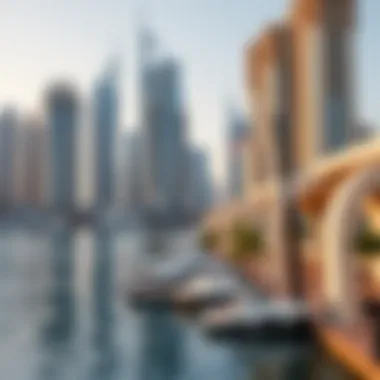
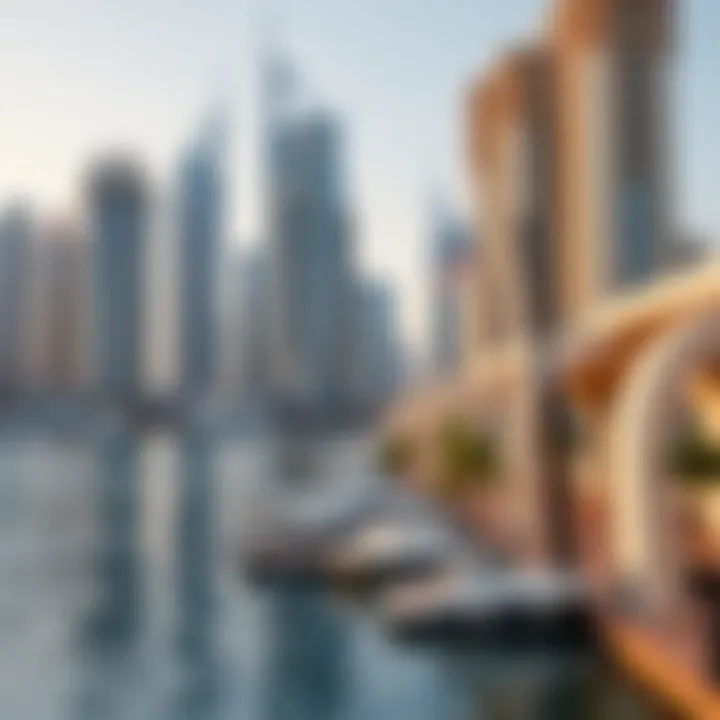
Currently under construction, One Za'abeel aims to become the tallest building in the world once completed, surpassing Burj Khalifa. This ambitious project not only highlights Dubai's commitment to pushing architectural boundaries but also reflects trends in sustainable building practices. Its advanced technology and environmentally friendly designs can enhance its appeal for investors interested in future-ready developments.
Nonetheless, its ongoing construction phases raise questions about community impact and potential disruptions.
Dubai Marina
Dubai Marina is not just a residential area but a masterful blend of design, lifestyle, and community. Offering a waterfront living experience coupled with leisure facilities, it is one of the most sought-after addresses in the city. The stunning promenade, lined with shops and dining options, enhances the overall ambiance of the area.
From a property perspective, it's a magnet for buyers and renters alike, often leading to high occupancy rates and property values. However, the popularity does lead to overcrowding, which might deter those looking for a more tranquil living environment.
The strides made in architectural innovation within Dubai not only propel the city into the future but also address the necessities and preferences of modern living, making it an essential theme to explore in the narrative of Dubai's scenic places.
Natural Attractions
Natural attractions in Dubai offer a refreshing contrast to the glittering skyscrapers and bustling urban life. These spaces not only appeal to visitors seeking tranquility but also serve as vital elements in enhancing the city’s livability and overall appeal to both residents and potential investors. The beauty of these locations lies in their ability to showcase the natural environment, which is often overlooked amidst the architectural wonders of the city. Whether it’s the vast desert landscapes or serene beaches, each site carries its distinct charm that can benefit the local economy and real estate market.
Desert Landscapes
Dubai Desert Conservation Reserve
The Dubai Desert Conservation Reserve is a prime example of Dubai's commitment to preserving its unique desert environment. Spanning over 225 square kilometers, it’s an extensive area dedicated to both conservation and education. The characteristics that make the reserve stand out include its rich biodiversity, including endangered species like the Arabian oryx and the sand gazelle. This aspect makes it a crucial point of interest for eco-tourism in Dubai.
One unique feature of the Dubai Desert Conservation Reserve is its sustainable tourism approach, giving visitors a chance to learn while enjoying wildlife experiences. Guided tours and educational programs emphasize the importance of protecting this delicate ecosystem. However, one disadvantage is that its remote location sometimes limits the accessibility for spontaneous visits. Visitors usually need to plan ahead, which could dissuade some who want instant adventure.
Al Marmoom Desert Conservancy
In contrast to the more tourist-centric Dubai Desert Conservation Reserve, the Al Marmoom Desert Conservancy focuses on cultural heritage and local community involvement. This conservancy covers an area of about 10% of Dubai’s total land area and offers a glimpse into the traditional Bedouin lifestyle. It fosters a sense of connection between the past and the present, making it much more than just a natural attraction.
The conservancy stands out due to its community-based initiatives, such as hosting cultural events that make it a popular venue for both locals and tourists. A significant unique feature is the annual running event, the Marmoom Marathon, which draws participants from around the globe, showcasing the harmony between nature and cultural pursuits. However, a consideration for visitors is the limited facilities in the area, which might require some planning ahead to ensure a comfortable experience.
Desert Safaris
Desert safaris are perhaps the most famous way to experience the natural beauty of Dubai’s deserts. These excursions often include thrilling activities like dune bashing, camel riding, and stargazing, providing a multifaceted experience that attracts a wide range of tourists. The core appeal is the adventure and adrenaline rush, making it a standout option for those looking to escape the city's hustle and bustle.
What makes desert safaris particularly beneficial for Dubai is their ability to drive tourism and stimulate the local economy, from the operators running the safaris to the support services such as catering. A unique feature of these safaris is the inclusion of traditional Bedouin cuisine and entertainment, creating a culturally rich experience.
However, there are some considerations. The popularity of desert safaris can lead to overcrowding in certain areas, which may momentarily detract from the serene experience that many visitors are seeking. Still, they remain a top choice for first-time visitors, balancing adventure and an introduction to the captivating desert landscape.
Beaches and Waterfronts
Jumeirah Beach
Jumeirah Beach is arguably one of Dubai's most recognized natural attractions. With its pristine white sands and clear blue waters, it serves as a luxurious backdrop for relaxation and recreation. The beach plays a crucial role in enhancing Dubai's reputation as a tourist hotspot, making it immensely popular among both tourists and expats alike.
The beach’s key feature is its range of facilities, including nearby hotels and beach clubs offering a variety of activities. This makes Jumeirah Beach a beneficial choice for relaxation and social gatherings, with a stunning view of the iconic Burj Al Arab in the distance.
A disadvantage, however, might be the crowds, especially during weekends and holidays, which can detract from the sense of seclusion some might seek.
Kite Beach
Kite Beach is well known for its active atmosphere, catering to a more youthful crowd, especially those interested in water sports. It boasts a colorful beachfront covered in people flying kites on windy days, which lends it its name. This characteristic makes it a hot spot for outdoor enthusiasts looking for a mix of fun and fitness.
The appealing feature here is the variety of food trucks and beachside cafes offering refreshments and meals, creating a vibrant social scene. This makes Kite Beach a great choice for young people and families. The downside includes limited parking and sometimes busy public spaces, which might prepare visitors better for their trips.
Al Mamzar Beach Park
Al Mamzar Beach Park merges beach relaxation with park-inspired activities, making it unique among Dubai’s beaches. With well-kept gardens, picnic areas, and dedicated swimming zones, it caters to families looking for a variety of activities in one place. This diversity enhances its appeal as a full-day destination.
The park’s unique feature is the combination of natural beauty with organized spaces for gatherings and events, making it a perfect choice for both tranquil outings and social activities. However, the parking can be somewhat of a headache on weekends, as many families flock to enjoy its amenities.
Parks and Green Spaces
The development of parks and green spaces holds significant importance in Dubai's urban and natural landscape. These areas are not merely patches of greenery; they serve as essential havens for relaxation, recreation, and community engagement amid the bustling city life. Parks can improve air quality and promote biodiversity, acting as lungs for the city, while also heightening the overall livability factor which is indispensable for residents and visitors alike. The focus on green spaces reflects Dubai's commitment to fostering a balanced lifestyle, which is increasingly considered by homebuyers and investors as they seek environments that offer both modern amenities and opportunities for outdoor leisure.
Public Parks
Zabeel Park
One standout feature of Zabeel Park is its sprawling layout, which covers approximately 47 hectares. It offers a variety of spaces for families and individuals to enjoy. The park's signature feature, a vast lake at its center, attracts numerous picnickers and joggers, providing a picturesque backdrop for leisure activities. Zabeel Park is well-known for its accessibility, situated centrally and easily reachable by public transport. A unique quality of Zabeel Park is its integration of technology, highlighted by a system that allows visitors to access real-time information about park facilities via their smartphones.
Advantages of Zabeel Park include its abundant shade trees, extensive walking paths, and the fascinating Dubai Dolphinarium nestled within its grounds, making it a popular choice for families. However, its large size can sometimes lead to crowded areas during weekends, particularly around its events and activities.
Dubai Creek Park
Dubai Creek Park is another jewel in the city's collection of green spaces, stretching along the edge of Dubai Creek. This park boasts a lush setting ideal for outdoor activities such as cycling, jogging, and leisurely strolls. One of its key characteristics is the expansive BBQ areas that invite families and friends alike to gather and enjoy shared meals outdoors. The park’s botanical garden is a unique feature that adds an enchanting element, showcasing diverse plant species that thrive in the region.
This park's advantages stem from its beautiful views alongside the creek, offering a blend of nature and cityscape that is hard to find. Nonetheless, it can be a tad less advantageous for those seeking solitude amidst nature, as the various facilities might draw larger crowds, especially during holidays.
Al Qudra Lakes
Al Qudra Lakes present a striking contrast to the urban environment of Dubai, offering a serene escape in the desert. Comprising a series of man-made lakes, this area fosters a unique ecosystem that supports local wildlife, particularly various migratory birds. This ecological aspect enhances its value as a recreational venue anchored in nature’s charm, making it indispensable for nature enthusiasts and those seeking tranquility.
The key feature of Al Qudra Lakes is undoubtedly the picturesque sunsets that paint the sky as visitors relax by the water. The designated picnic areas provide families with space to unwind and enjoy a day out in nature. However, one disadvantage is the lack of facilities, which some may find inconvenient when compared to the more urban parks. Visitors often must bring their own supplies, which may deter those who prefer fully serviced parks.
Botanical Gardens
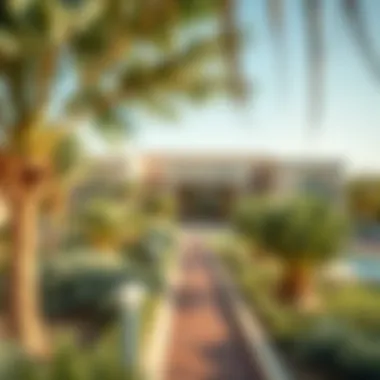
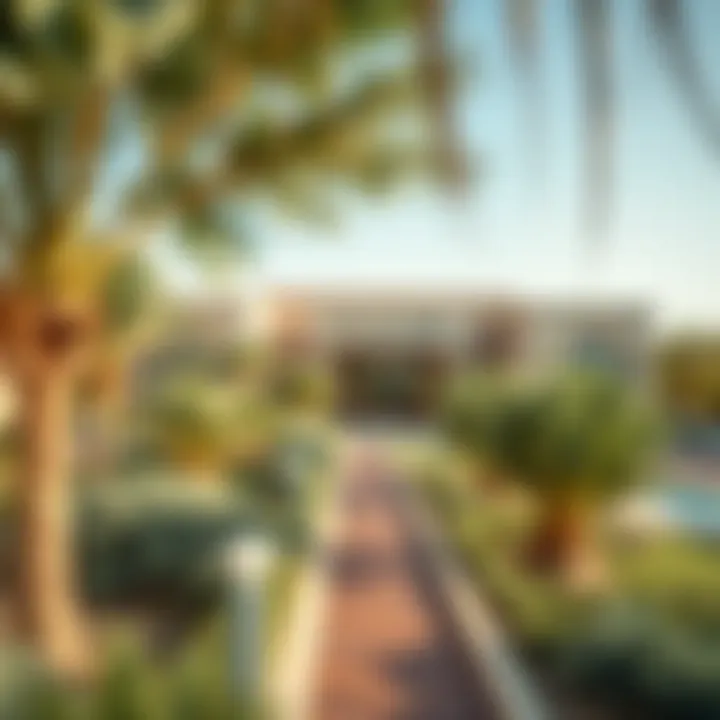
Dubai Miracle Garden
Among the most stunning botanical destinations is the Dubai Miracle Garden. Featuring an astounding collection of over 150 million flowers, this garden transforms into a floral spectacle every season. One of its key characteristics is the breathtaking flower sculptures and themed displays that charm visitors, making it a popular choice among families and photographers alike. It provides a visual feast that not only enhances cultural appreciation for horticulture but also supports local tourism.
The garden’s unique feature is its seasonal structure, where blooms are refreshed and changed each year, offering a new experience for repeat visitors. However, the garden is only open during the cooler months, which can limit access and frustrate those wishing to visit during the hotter months.
Dubai Butterfly Garden
The Dubai Butterfly Garden offers an intimate experience that complements its floral neighbor. This garden houses thousands of butterflies fluttering among beautifully designed floral surroundings, creating a magical atmosphere. Its focus on marine and urban biodiversity education makes it valuable for both young minds and seasoned naturalists, presenting an environment where education and leisure intermingle.
Its key feature is the climate-controlled butterfly domes that provide a habitat for various butterfly species, even as the city outside remains hot. Family-friendly programs further reinforce its appeal for educational outings. On the downside, though the garden is captivating, its smaller size might leave some visitors wanting more, as compared to larger parks or gardens.
"Parks and green spaces are not just luxuries; they are essentials that elevate life quality for everyone."
This careful consideration of parks and green spaces within Dubai not only highlights their aesthetic appeal but also underscores their role as a crucial aspect of urban planning and sustainable development.
Cultural and Historical Sites
Cultural and historical sites in Dubai offer a fascinating window into the emirate's rich heritage and evolution. As the city has transformed itself from a modest fishing village into a sprawling metropolis, these locations hold significant relevance for both residents and tourists. They stand as testaments to Dubai's deep-rooted traditions while simultaneously positioning it as a modern hub. Understanding these sites not only contributes to a deeper appreciation of the region’s history but can also enhance one’s real estate investment insight here.
Heritage Areas
Al Fahidi Historic District
The Al Fahidi Historic District serves as a treasure trove of the past, proudly preserving Dubai’s traditions and architecture. One key characteristic of this area is its narrow lanes and wind-tower buildings, which showcase the ingenuity of Emirati engineering before the age of air conditioning. This historic enclave, once known as Bastakiya, offers a glimpse into what life was like in Dubai before the skyscrapers took over.
Visitors are often drawn to its art galleries and museum spaces that exhibit the local culture, making it a beneficial choice for those who want to immerse themselves in Dubai's history. A unique feature is the "diwan" style courtyard houses, acting as social hubs. While the authenticity of Al Fahidi is its biggest advantage, it also faces the challenge of balancing preservation with the growing tourist influx.
Dubai Museum
Dubai Museum is another must-visit for anyone interested in the city’s history. Housed within the Al Fahidi Fort, which is itself a historical landmark, this museum offers a compelling narrative of Dubai’s transition from a small pearl diving center to a global city. The interactive displays and traditional artifacts provide invaluable insights into the daily lives of Emiratis in the past.
What makes this museum appealing is the way it incorporates both history and culture, making it a popular educational resource. A unique feature is the museum's life-size dioramas depicting scenes from the past, giving visitors a taste of what it was like to live in early Dubai. While some may find the museum small compared to sprawling modern venues, its charm lies in its intimate storytelling, making it well worth a visit.
Sheikh Saeed Al Maktoum House
The Sheikh Saeed Al Maktoum House adds to the cultural tapestry of Dubai. This historical residence was home to the former ruler of Dubai and now stands as a museum that showcases the family's legacy and the history of Dubai. The architectural design makes it one of the finest examples of traditional Emirati homes, featuring intricate wooden latticework and coral stone.
Its significance in this article stems from its role as a symbol of the emirate’s past. It allows visitors to understand the sociopolitical backdrop of early 20th-century Dubai. A unique feature of this house is its original artifacts, including photographs and documents that chart Dubai's development. Though it may not attract large crowds like newer attractions, its historic value and serene environment provide a captivating experience worth celebrating.
Art and Culture
Dubai Opera
Dubai Opera stands as a beacon of art and culture in the city. With its dhow-shaped silhouette, the venue itself is a masterpiece and represents Dubai’s commitment to the arts. This multifaceted space hosts a range of performances, from opera and ballet to contemporary concerts, making it a cultural hub for residents and visitors alike. Its location in Downtown Dubai puts it at the heart of the city, easily accessible for anyone wanting to soak in world-class performances.
Unique features include the breathtaking views of the Burj Khalifa, which adds a dramatic backdrop to events. The architectural design and state-of-the-art acoustics are significant advantages, setting a high bar for performance venues. Despite its acclaim, some critics argue that tickets can be pricey, making access a bit limited for some segments of the population.
Alserkal Avenue
Alserkal Avenue is another cornerstone of Dubai's art scene that supports a growing community of galleries, studios, and creative spaces. Located in the Al Quoz district, it reflects the city's artistic aspirations while offering a platform for emerging and established artists.
Alserkal Avenue is characterized by its eclectic mix of contemporary art galleries and creative spaces, making it a popular choice for art lovers. The area frequently hosts talks, exhibitions, and festivals, ensuring a vibrant atmosphere year-round. Its unique feature lies in its collaborative spirit and engagement with the community, fostering a sense of belonging. However, for those seeking a more historical context, it may feel a bit disconnected from the city's deeper heritage.
Jameel Arts Centre
Jameel Arts Centre adds another layer to Dubai's cultural landscape, emphasizing contemporary art through its diverse exhibitions. This waterfront hub contains an array of spaces for exhibitions, events, and a library, promoting research and exploration in the arts. Its commitment to showcasing both local and international talent makes it a special spot in the city.
A critical aspect of the Jameel Arts Centre is its focus on community engagement, fostering workshops, and artist residencies that connect the public with art. The architectural design of the centre further enhances its appeal, integrating outdoor areas for social events, even if some crowds may find the open spaces less comfortable in hotter months. With its unique approach, it stands out as a significant contributor to Dubai's contemporary cultural identity.
These cultural and historical sites weave the charm of Dubai’s heritage into the fabric of its modern-day narrative, helping local residents and potential investors understand the value of rich stories behind the Emirate's stunning landscapes.
Shopping and Entertainment Destinations
Shopping and entertainment in Dubai are not just about purchasing goods or attending shows; they reflect the city's economic vibrancy and cultural diversity. These areas serve as hubs where locals and expats alike can enjoy leisure time, socialize, and immerse themselves in a unique blend of traditions and modernity. The importance of these destinations goes beyond mere consumerism; they enhance the city's livability and contribute significantly to the real estate market by attracting investment and tourism.
Malls and Retail Spaces
The Dubai Mall
The Dubai Mall is not just a mall; it’s an entire experience. As one of the largest shopping centers in the world, it represents a key characteristic of Dubai's ambition and luxury. The mall encompasses over 1,200 retail shops, featuring everything from high-end brands to more accessible labels, thus catering to diverse shopping preferences.
A significant asset of the Dubai Mall is its proximity to the Burj Khalifa and the Dubai Aquarium. These features make it a favored choice for tourists and residents. One highlight is the Dubai Fountain, which performs spectacular water shows, drawing in crowds regularly. However, the sheer size of the mall can be overwhelming, and during peak tourist seasons, the crowds can make shopping less enjoyable.
Mall of the Emirates
Mall of the Emirates stands out primarily for its indoor ski slope, Ski Dubai, which is a unique feature not commonly found elsewhere. It's a key draw for both families and adventurous individuals, allowing them the chance to ski or snowboard in a desert city.
In addition to this, the mall hosts an array of international shopping outlets and fine dining options, making it a comprehensive destination for leisure and retail therapy. Its design echoes the essence of regional culture alongside global influences, making it a popular choice. On the downside, the need for extensive parking facilities can sometimes make access tricky, especially during busy weekends or holidays.
Souk Madinat Jumeirah
Souk Madinat Jumeirah captures the essence of traditional Arabian markets while integrating modern architecture and amenities. A key characteristic of this destination is its charming waterways, offering picturesque views and a relaxed shopping experience. Visitors here can find artisanal souvenirs, fashion boutiques, and dining spots that overlook the water.
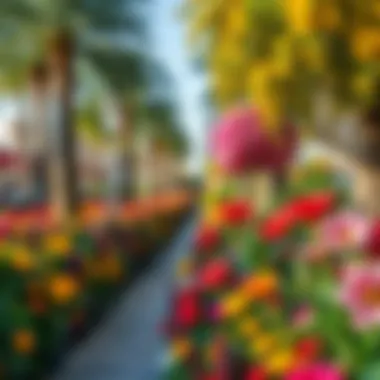
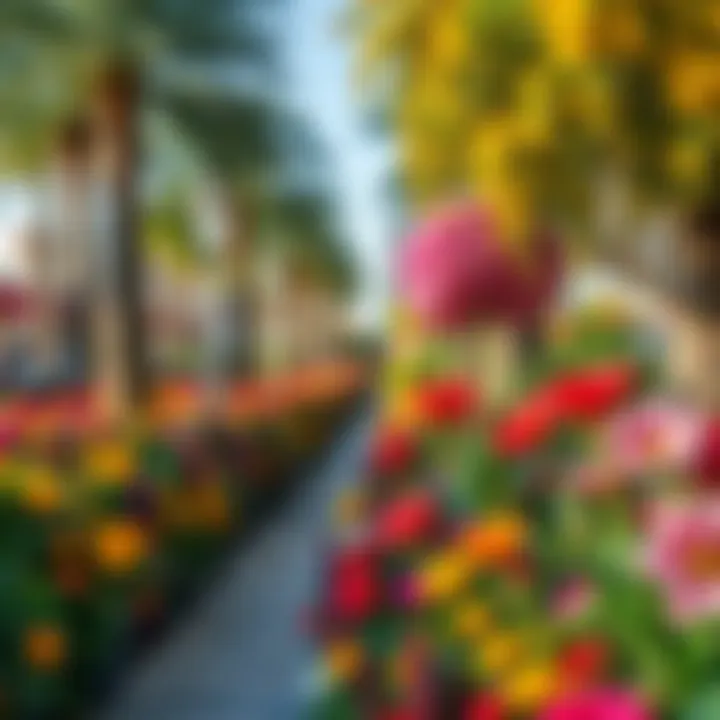
One of the unique features of the Souk is its cultural events and festivals that take place throughout the year, enhancing the shopping experience. This blend of culture and commerce contributes positively to Dubai’s image as a tourist-friendly city. However, the pricing can be higher compared to other retail spaces due to its premium positioning.
Entertainment Venues
IMG Worlds of Adventure
IMG Worlds of Adventure is notable for being one of the largest indoor theme parks in the world. Its thematic areas cater to all age groups with thrilling rides and attractions based on popular cartoons and movies. This makes it a go-to spot for families looking for a full day's worth of entertainment.
The anchor of its appeal is the unique blend of excitement and comfort, allowing visitors to have fun without the sweltering heat of the outdoors. However, ticket prices might come off as steep for some, potentially limiting the audience.
Dubai Parks and Resorts
Dubai Parks and Resorts embodies a multifaceted entertainment destination featuring multiple theme parks within a single complex. This includes Motiongate Dubai, Bollywood Parks, and Legoland, each offering diverse entertainment tailored to different age brackets and interests.
It's characterized by seasonally themed events and shows that attract a wide range of visitors, making it a significant player in Dubai’s tourism sector. It brings families together for memorable experiences, which is a key component in promoting local tourism. While the entertainment is unparalleled, the vastness can make it a logistical challenge, particularly when navigating between parks.
In summary, Shopping and Entertainment Destinations in Dubai play a crucial role in shaping the city's identity. They not only offer consumer goods and leisurely pursuits but also serve as community gathering spots that enhance the overall livability and appeal of the city, thus influencing both real estate trends and tourism.
For more information, you can visit resources like Dubai Mall, Mall of the Emirates, Souk Madinat Jumeirah, IMG Worlds of Adventure and Dubai Parks and Resorts.
The Future of Scenic Developments
The importance of the future of scenic developments in Dubai cannot be overstated. As the city evolves, it continuously seeks to blend modernity with sustainability and livability. The next wave of projects reflects a commitment to innovative design and environmental concerns, all while enhancing the aesthetic charm of Dubai. This evolution speaks to both residents and investors, as new developments not only signify growth but also attract attention for their investment potential.
In a city known for its astonishing skyline and opulent lifestyle, the upcoming initiatives aim to create unique spaces that foster community and connection with nature. Exploring the advancements in infrastructure, environmental efforts, and the overarching commitment to sustainability offers a holistic view of how Dubai is shaping its environment for the future.
Upcoming Projects
Dubai Creek Harbour
Dubai Creek Harbour is an ambitious project set to redefine waterfront living in Dubai. This development boasts a unique blend of urban chic with natural splendor, featuring a sprawling park that integrates seamlessly with the waterfront. One of its standout characteristics is the towering Dubai Creek Tower, which promises to be an architectural marvel, aiming to surpass the Burj Khalifa.
Key benefits for this article:
- Centralizing cultural and recreational amenities around the creek allows for a vibrant community life.
- Promotes eco-friendly practices with green spaces and pedestrian pathways.
Unique features like the extensive waterfront walkways and lush parks elevate its appeal. However, the rapid urbanization may pose risks to the local wildlife, needing careful planning and management.
Bluewaters Island
Bluewaters Island represents a fusion of lifestyle, leisure, and luxury. This island is home to the famous observation wheel, the Ain Dubai, providing stunning views of the city skyline and the Arabian Gulf. Its key characteristic is the striking combination of residential, hospitality, retail, and entertainment offerings.
Highlights for this article:
- Its vibrant atmosphere draws both tourists and residents, making it a bustling hub of activity.
- The blend of entertainment with exclusive residential options showcases a dynamic community concept.
The waterfront living it offers, along with the proximity to Jumeirah Beach, positions Bluewaters Island as a popular choice for those seeking both leisure and investment opportunities. Yet, concerns about accessibility during peak hours have been noted and require addressing.
Dubai Marina Expansion
The Dubai Marina expansion is a pivotal project aimed at augmenting the already impressive marina lifestyle. This development will introduce additional residential units, commercial spaces, and leisure facilities while maintaining the iconic marina aesthetic. Its key characteristic lies in enhancing connectivity between different areas, which is crucial for both residents and tourists alike.
Why it matters for this article:
- Boosts the livability of Dubai by integrating new developments into existing infrastructural frameworks.
- Offers investment opportunities with enhanced recreational amenities.
Noteworthy features include promenades, parks, and entertainment zones designed to foster community interaction. The potential downsides, such as increased traffic congestion, could challenge existing infrastructure, making effective urban planning essential.
Environmental Sustainability Efforts
Green Building Initiatives
Green building initiatives in Dubai signify a profound commitment to sustainable architecture. These practices encourage the use of environmentally friendly materials and technologies designed to minimize energy consumption. A prominent aspect of these initiatives is the rigorous adherence to LEED certification standards, setting benchmarks for future developments.
Why this is beneficial:
- It enhances the overall quality of life by reducing pollution and creating healthier living environments.
- These buildings often lead to cost savings for both developers and occupants in terms of energy efficiency.
Unique features such as solar panels, green roofs, and smart technologies highlight the city’s commitment to forging a sustainable future. However, the initial higher costs of sustainable materials can be a barrier for some developers.
Sustainable Tourism Practices
Sustainable tourism practices are gaining traction in Dubai as the city recognizes the need to balance economic growth with environmental protection. Initiatives include promoting eco-friendly hotels, using local resources, and facilitating responsible travel campaigns. One notable aspect is the integration of traditional heritage with modern experiences, enhancing community engagement for visitors.
Benefits of this approach:
- It encourages tourists to appreciate local culture while fostering economic stability for residents.
- Reduces the negative footprint of tourism on natural resources and ecosystems.
Unique features like eco-tours and community-based projects bolster local economies and enhance visitor experience. Yet, striking a balance between tourism growth and environmental sustainability remains a complex challenge that necessitates ongoing dialogue among stakeholders.
Finale
As we draw the curtain on our exploration of Dubai's scenic locales, it becomes evident that the city is more than a desert oasis awash with opulence; it’s a tapestry of diverse experiences waiting to be savored. The key takeaway from this journey through architectural splendor and natural sanctuaries is the significance of these places not only as tourist magnets but also as vital components enhancing livability and investment potential.
In considering Dubai's scenic environment, various factors shine through:
- Architectural Marvels: The skyline of Dubai with its towering edifices such as the Burj Khalifa contributes significantly to its real estate landscape. Such structures don’t just offer stunning views but serve as symbols of investment opportunity. When homebuyers or investors assess their options, they gravitate toward areas boasting these iconic landmarks.
- Natural Wonders: Location matters. The proximity of natural attractions like Jumeirah Beach or the Dubai Desert Conservation Reserve not only enriches the lifestyle of residents but also appeals to those looking to move to the city. They beckon not only for relaxation but also for family-friendly activities that make Dubai a great place for expatriates.
- Cultural Dimensions: Our exploration also touched on Dubai's historical and cultural sites, which add layers to the city’s identity. Heritage sites like Al Fahidi Historic District and contemporary art hotspots like Alserkal Avenue show how tradition and modernity coalesce, fostering community and enhancing the overall living experience.
- Future Development: The ongoing projects, including Dubai Creek Harbour, illustrate that there’s much yet to unfold. The real estate market continues to grow and evolve, making it a prime landscape for investment. Environmentally-sensitive developments and green initiatives elevate the appeal further, aligning with increasing global attention towards sustainability.
Ultimately, one could argue the enduring allure of Dubai lies in this charming duality. The blend of aspirational living alongside rich, scenic value makes it a desirable hub for homebuyers and investors alike.
"In a city where dreams meet reality, the true essence of living is captured in the spaces we inhabit."





